
Home » Providence boosts its outpatient stroke care
Providence boosts its outpatient stroke care
Walz stresses importance of women caring for selves

January 18, 2018
While the symptoms of a stroke in men and women are generally consistent, there is frequently a profound difference in the way members of each gender handle their recovery after the fact, says Dr. Beth Walz of Providence Health Care.
“I saw this just today,” Walz says in her southern Ohio accent. “I’m outlining the aftercare process with a patient and her adult daughter, and talking about the things she needs to do and pay attention to get well during her recovery.”
After several minutes of explaining the next steps, Walz says, the patient interrupts to say there’s no way for her to be able to dedicate sufficient time to her own recovery because she has to take care of her husband and his medical needs.
“I have to say this more to women than to men: It’s now time to take care of you,” says Walz, a neurologist. “You can’t be a good caregiver if you don’t care for yourself.”
Fortunately, in that case, Walz says her patient has a strong support network of family and friends to help her recuperate.
“Her daughter reassured me and sent a firm message to her mother that she and the family weren’t going to allow her to do more than she could take on,” Walz says.
That kind of pep talk is one reason Providence hired Walz last March—to encourage patients to face certain challenges that in other situations they might ignore.
Providence Health Care recruited Walz from The Ohio State University Wexner Medical Center, based in Columbus, Ohio. The multidisciplinary academic medical center is considered a leader in central Ohio for health care and medical research.
Walz also serves as a fellow to the American Heart Association and is affiliated with the American Academy of Neurology.
Walz now works alongside fellow neurologist Dr. Jennifer Pary as part of the recently established Providence Stroke & Cerebrovascular Disorders Clinic, located on the first floor of the Sacred Heart Doctors Building, at 105 W. 8th.
Providence established the clinic last March in roughly 2,000 square feet of space to assist stroke sufferers with their recovery efforts, Walz says.
The stroke and cerebrovascular clinic has a total of five exam rooms, each of which can accommodate a physician, a patient in a wheelchair, and a few family members, says Walz, who credits Pary for helping to insure the clinic got set up in that space.
“It clearly played a role in my decision to come to Providence,” she says. “It’s vital for patients, their support, and medical staff to have the kind of space to make everyone feel comfortable.”
Walz says Providence Health Care envisions establishing a similar clinic at Providence Holy Family Hospital, at 5633 N. Lidgerwood on Spokane’s North Side.
Today, the American Stroke Association estimates a third of U.S. adults have had symptoms consistent with a ministroke, also called a transient ischemic attack. The symptoms are similar to a more severe ischemic stroke, but TIA symptoms usually last less than five minutes, with an average of about a minute in length.
Indicators of a TIA may include feeling faint, lightheadedness, or vertigo, difficulty walking, muscle weakness on one side of the body and slurred speech, all of which occur as a result of a temporary blockage of blood flow to the brain.
Both the American Heart Association and American Stroke Association say TIAs can be relatively benign in terms of immediate consequences. However, a ministroke needs to be viewed more appropriately as a warning stroke because it often is a precursor to a full-blown stroke if left untreated.
People who have severe strokes often report having earlier warning strokes. Among patients treated for an ischemic stroke, between 7 percent and 40 percent report experiencing a TIA, according to the stroke association.
Medical factors that increase the risk of stroke include high blood pressure and diabetes. Lifestyle risk factors include obesity, tobacco use, physical inactivity, heavy drinking, and use of illicit drugs, such as cocaine and methamphetamines.
In her new position, Walz says she now has the opportunity to spend more time educating and providing support for stroke victims and their family in aftercare.
“It’s been a delight to be in this position, and we have the full support from (Providence) administration,” Walz says of her and Pary’s efforts.
Unlike other health issues than can arise, a small stroke doesn’t warrant an extended stay in the hospital, she says.
“It can be a whirlwind event from stroke to ER to release, and the patient often doesn’t know what happened,” Walz says. “Here, we can get to determining and identifying the cause of the stroke and begin the process of providing education and serving as the facilitator in helping them coordinate rehabilitative efforts and long-term care follow-up.”
So far, Walz says she’s been encouraged to see patients here respond quickly—and favorably—to medical advice.
“People here are much more willing to change their lifestyle,” she says.
Coming from Columbus, the medical facility where she worked drew residents from Kentucky and West Virginia.
“It was often people coming from a mining culture with diets that are high in fat and salt. Talking about a change in diet and exercise is a huge change,” she says.
Latest News Up Close Health Care
Related Articles
Related Products



